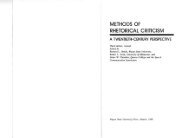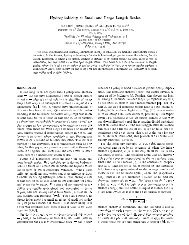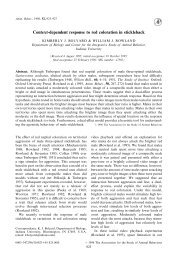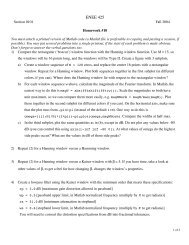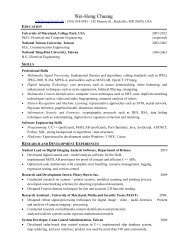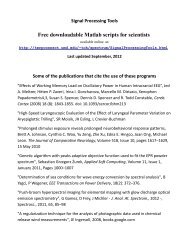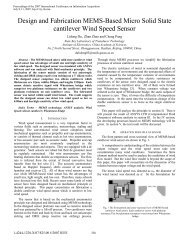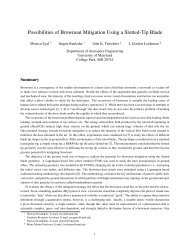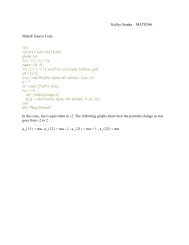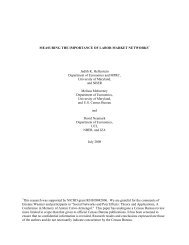Errors for Linear Systems When we solve a - TerpConnect
Errors for Linear Systems When we solve a - TerpConnect
Errors for Linear Systems When we solve a - TerpConnect
Create successful ePaper yourself
Turn your PDF publications into a flip-book with our unique Google optimized e-Paper software.
Question 1: How much error do <strong>we</strong> have to accept <strong>for</strong> ˆx−x<br />
x ? This is the unavoidable error which occurs even <strong>for</strong> an<br />
ideal algorithm where <strong>we</strong> only round the input values and the output value to machine accuracy, and use infinite accuracy<br />
<strong>for</strong> all computations.<br />
<strong>When</strong> <strong>we</strong> want to <strong>solve</strong> Ax = b <strong>we</strong> have to store the entries of A, b in the computer, yielding a matrix  and a right hand<br />
side vector ˆ b of machine numbers so that Â−A<br />
A<br />
linear system exactly, i.e., compute a vector ˆx such that ˆx = ˆ b. Then <strong>we</strong> have<br />
ˆx − x<br />
x ≤<br />
≤ εM and ˆ b−b<br />
b ≤ εM. An ideal algorithm would then try to <strong>solve</strong> this<br />
cond(A)<br />
(εM + εM) ≈ 2 cond(A)εM<br />
1 − cond(A)εM<br />
if cond(A) ≪ 1/εM. There<strong>for</strong>e the unavoidable error is 2 cond(A)εM.<br />
Question 2: After <strong>we</strong> computed ˆx how can <strong>we</strong> check how good our computation was? The obvious thing to check is<br />
ˆb := Aˆx and to compare it with b. The difference r = ˆb − b is called the residual. As Ax = b and Aˆx = ˆb <strong>we</strong> have<br />
<br />
<br />
ˆx − x<br />
<br />
≤ cond(A)<br />
x ˆ <br />
<br />
b − b<br />
b<br />
<br />
<br />
where ˆ <br />
<br />
b − b<br />
/ b is called the relative residual. We can compute (or at least estimate) cond(A), and there<strong>for</strong>e can obtain<br />
an upper bound <strong>for</strong> the error ˆx − x / x. Actually, <strong>we</strong> can obtain a slightly better estimate by using<br />
<br />
<br />
ˆx − x = A −1 <br />
ˆ <br />
b − b ≤ A−1 <br />
<br />
<br />
<br />
ˆ ˆx − x<br />
<br />
b − b<br />
=⇒ ≤ cond(A)<br />
ˆx ˆ <br />
<br />
b − b<br />
A ˆx<br />
<br />
<br />
<br />
with the <strong>we</strong>ighted residual ρ :=<br />
ˆ <br />
<br />
b − b<br />
. Note that ˆx − x / ˆx ≤ δ implies <strong>for</strong> δ < 1<br />
A ˆx<br />
ˆx − x ≤ δ x + (ˆx − x) ≤ δ (x + ˆx − x) =⇒<br />
ˆx − x<br />
x<br />
≤ δ<br />
1 − δ<br />
which is the same as δ up to higher order terms O(δ2 ).<br />
<br />
<br />
If ˆ <br />
<br />
b − b<br />
/ b is not much larger than εM then the computation was numerically stable: Just perturbing the input slightly<br />
from b to ˆ b and then doing everything else exactly would give the same result ˆx.<br />
But it can happen that the relative residual is much larger than εM, and yet the computation is numerically stable. We obtain<br />
a better way to measure numerical stability by considering perturbations of the matrix A:<br />
Assume <strong>we</strong> have a computed solution ˆx. If <strong>we</strong> can find a slightly perturbed matrix à such that<br />
<br />
<br />
à − A<br />
≤ ε,<br />
A<br />
Èx = b (2)<br />
where ε not much larger than εM, then the computation is numerically stable: Just perturbing the matrix within the roundoff<br />
error and then doing everything exactly gives the same result as our computation.<br />
How can <strong>we</strong> check whether such a matrix à exists? We again use the “<strong>we</strong>ighted residual”<br />
<br />
<br />
<br />
ρ :=<br />
ˆ <br />
<br />
b − b<br />
A ˆx .<br />
Then:<br />
1. If ˆx is the solution of a slightly perturbed problem (2) <strong>we</strong> have ρ ≤ ε.



